Table of Contents
- Mass email blasts trigger penalties and underperform — Gmail, Outlook, and Yahoo now penalize bulk, untargeted PR outreach.
- Smaller, hyper-targeted campaigns earn 17x more links — Based on analysis of 31M emails and 80K digital PR campaigns.
- Relevance now includes topic, geography, timing, and format — Generic “food” or “news” targeting isn’t enough anymore.
- Journalists want exclusivity and specificity — Most reporters ignore mass-pitched studies that don’t match their actual beat.
- Tools like ListIQ automate building context-rich media lists — Pulls author bios, recent articles, and verified emails from Google News.
- Personalized outreach takes more time but delivers 3–5x ROI — Examples show success with <50 emails per angle and >150 links.
Digital PR is super easy, right?
All you really have to do these days is get a city study and blast it out to 3000 people.
Heck, for a large city index study, this LinkedIn post is telling me I can send it out to 10,000 people!
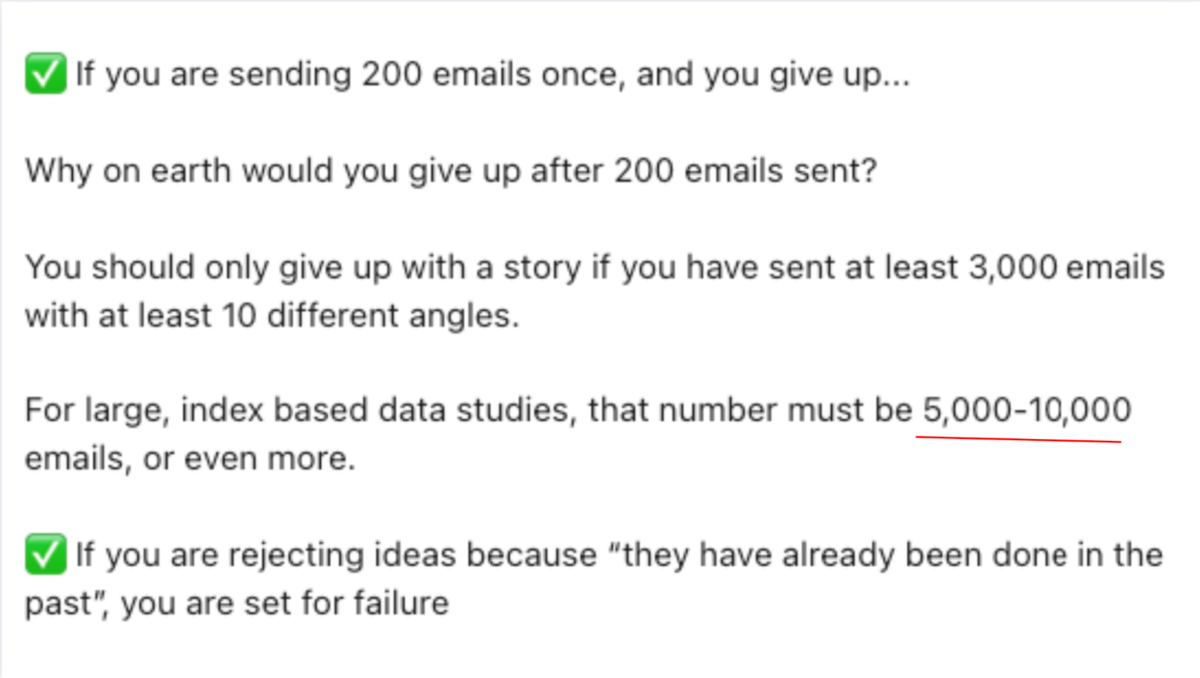
Then, I’ll just sit back and watch those links roll in, right?
We know it’s not that easy.
In this post I’m going to show you why.

If you’d like to jump down to the deck, click here!
A Quick Story
Let me start with a quick story.
We had a customer come to us looking to do the same thing I just laid out in that scenario.
They were following what they saw on LinkedIn and wanted to send thousands of emails per day for their campaigns.
But before they could even get anything sent out, they were banned by their email provider.
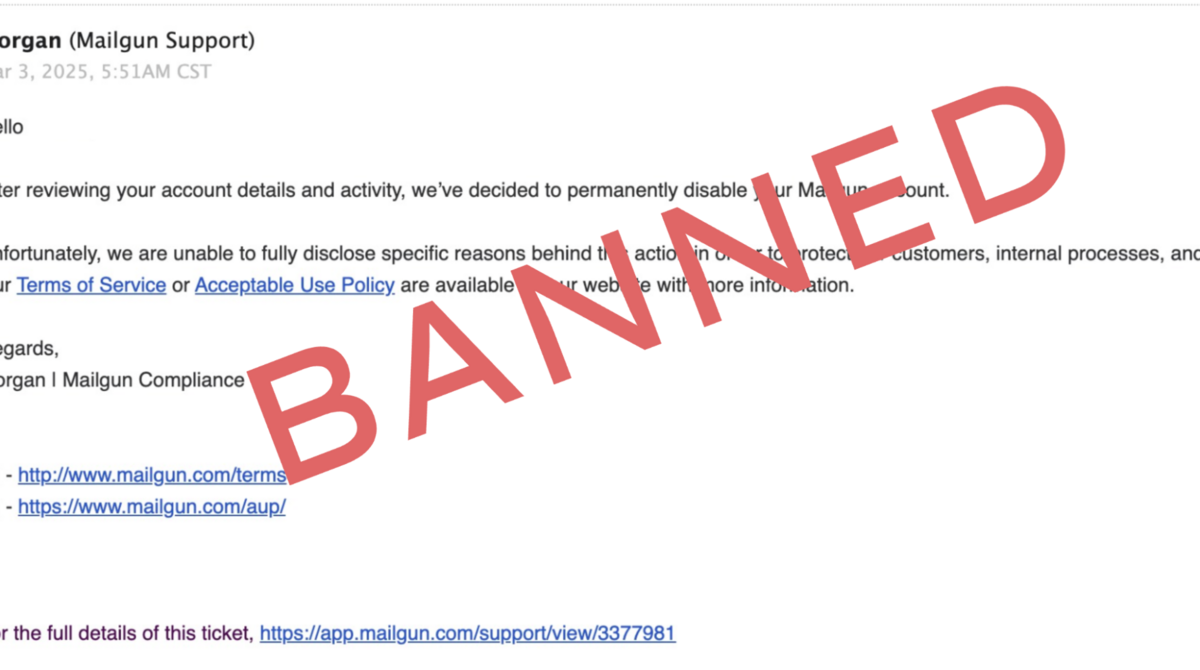
They changed their tactics a bit, but ultimately they were banned again by Google.

It’s easy to call out these blatantly wrong decisions and blatantly wrong tactics and strategies.
(I promise I’m gonna come back to that story because there’s a happy ending to that one customer.)
But the fact of the matter is, the people who even think they’re being relevant and targeted are not being relevant and targeted enough.
And we analyzed 31 million emails to prove that the smaller, more targeted campaigns outperform these large generic blasts by a significant margin.
The Old Strategies Aren’t Working Anymore
The reason that I think many of us are finding this stuff challenging is that the old strategies are just not working.
We’ve had plenty of customers come to us at BuzzStream saying, last year, I would send out campaigns and would get a hundred likes.
But nowadays you’re getting 3, 5, 10 maybe, if I’m lucky.
So the old strategies are not working.
And if you are feeling this, you are not alone.
In our State of Digital PR Report, we found 71% of people said that it’s more challenging.
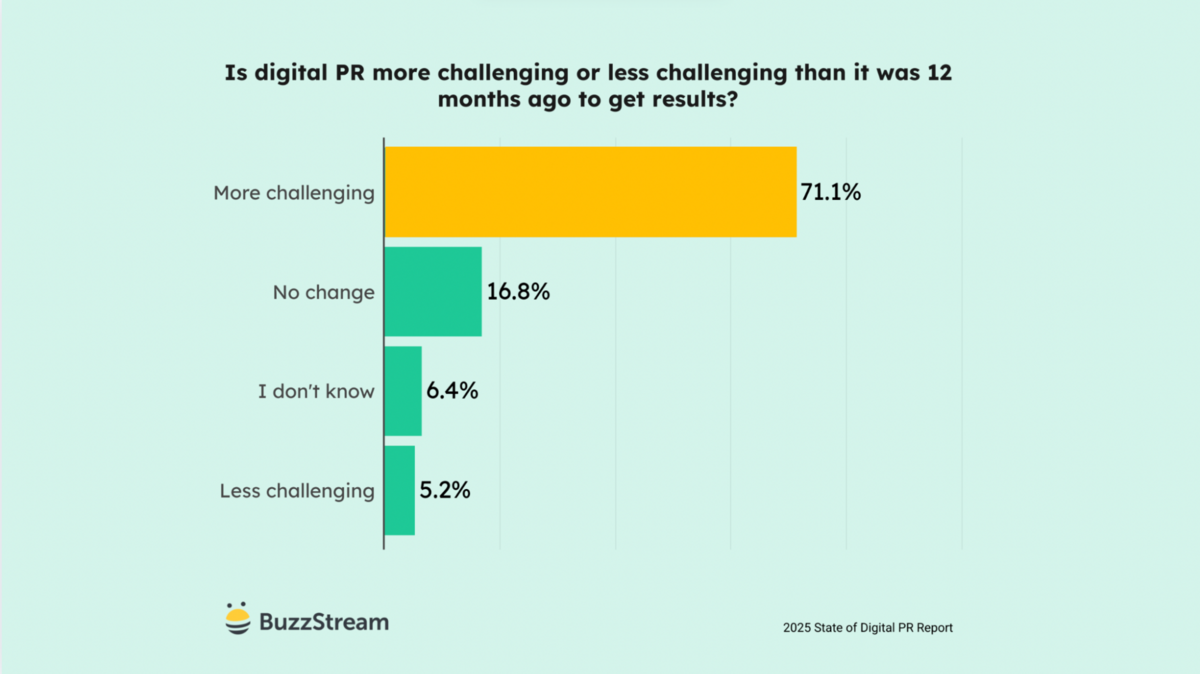
When things get tough, the urge I think, is to send more emails.
If you’re not getting responses, you’re not getting links you need, you feel like you need to expand your reach.
We are seeing that more people are doing this.
Email sends her up 18% since 2023.

It used to be this easy: you would go into a media database, you would do some keyword search and find people in their bios and make this big list.
Or you could maybe go into Twitter, do the same thing, look at their bios, and you find journalists, and export these lists and blast it out.
But it’s just not how it works these days.
There are a couple of reasons for this:
News sites are cutting journalists.
So there’s this shrinking pool of journalists, and the ones that remain are overworked.
They’re jumping around, they’re covering a lot more beats and a lot more areas.
And on the other side of the coin, we’re seeing this massive increase in interest in digital PR.
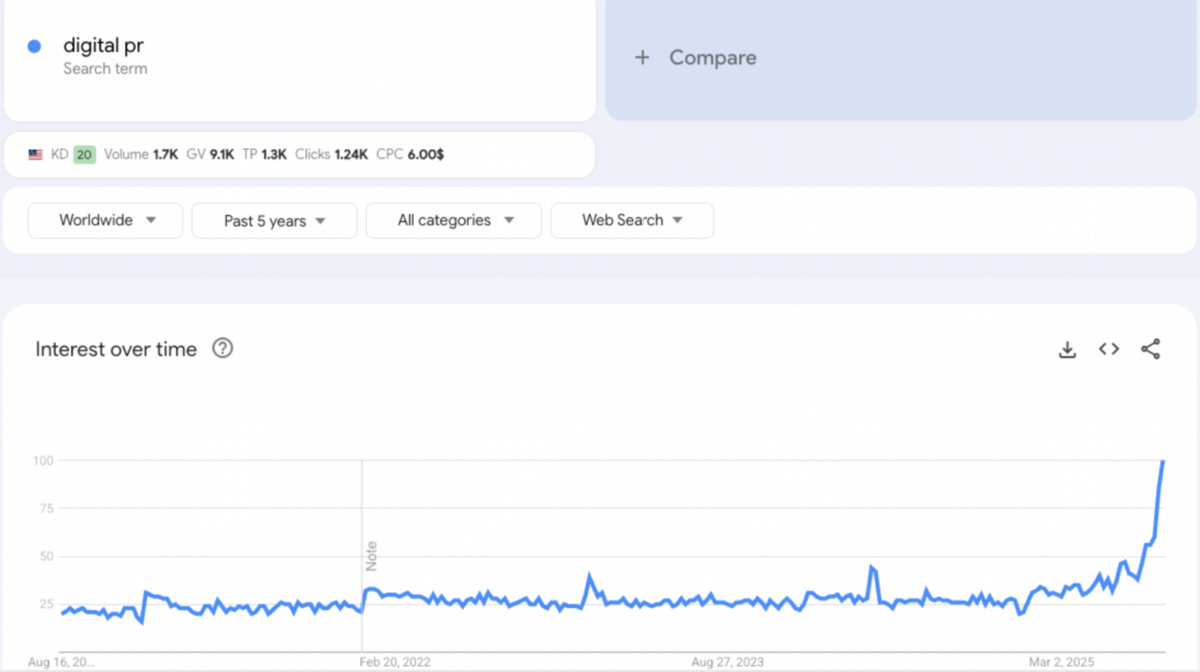
We’re seeing so many agencies that were link building agencies now positioning themselves as digital PR agencies.
And there are many more people looking for digital PR services.
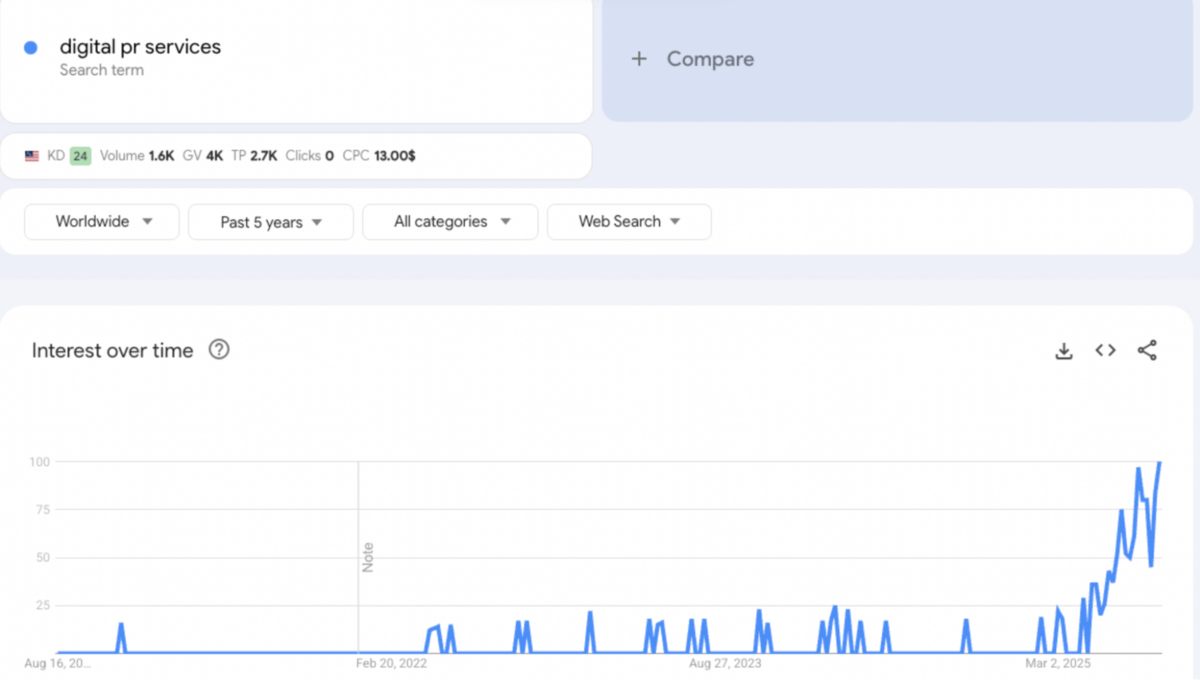
So it’s this shrinking pool of journalists and a lot more people in the space.
And what that’s adding to is just the pitches here, we’re seeing 15% more pitches according to Muck Rack.
And this is the kicker here: half of the journalists seldom or never get relevant pitches, according to MuckRack’s State of Journalism.

So this should really tell you all you need to know about the state of the industry right now.
I think the issue is we typically spend most of the time building 10% of our list.
The VIPs.
And then you fill out the rest of the list with people who might answer and they might not.
What’s the big deal?
On the one hand, journalists are going to mark us as spam, and they’re going to ignore you.
But there are also other repercussions.
Google, Yahoo, and now Outlook have all rolled out these penalties this year for people sending generic email blasts.
And the very worst case scenario, is that you get banned, which obviously is not what we want as PR pros.
We need to be way more targeted than we think
Let’s look at the data.
We ran a big study of over 31 million emails and 80k campaigns and found that smaller, more targeted campaigns had:
- 16% higher open rates.
- 68% higher reply rates.
- 17 times more links.
You can read the full study here.
I don’t want you to take away from this that the smaller lists are better because that’s not what I’m saying.
I’m not saying you can just cut your list in half.
These lists tend to be smaller because it typically takes a long time to build these more targeted, relevant lists.
Relevance is not what you think it means anymore
Let’s put ourselves in the journalist’s shoes for a second.
I’m gonna introduce you to Rosie Taylor.
As her bio page states, she is an award-winning journalist specializing in health and consumer topics, particularly issues affecting women and families.
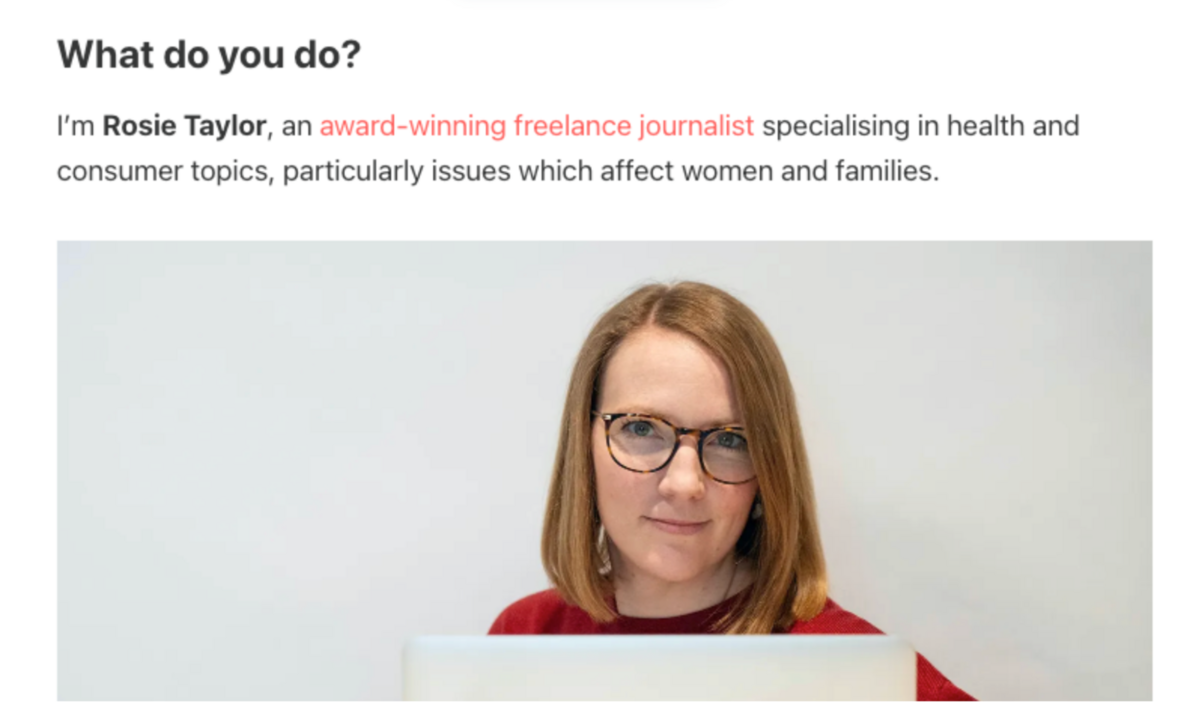
Now let’s look at her inbox.
Scan this the way Rosie might, and tell me which emails are relevant.

My guess was about five.
But realistically, when I asked Rosie about this, there were no relevant stories.
Nothing in that inbox had anything to do with women specifically.
And you can see from her stories that this is the focus:
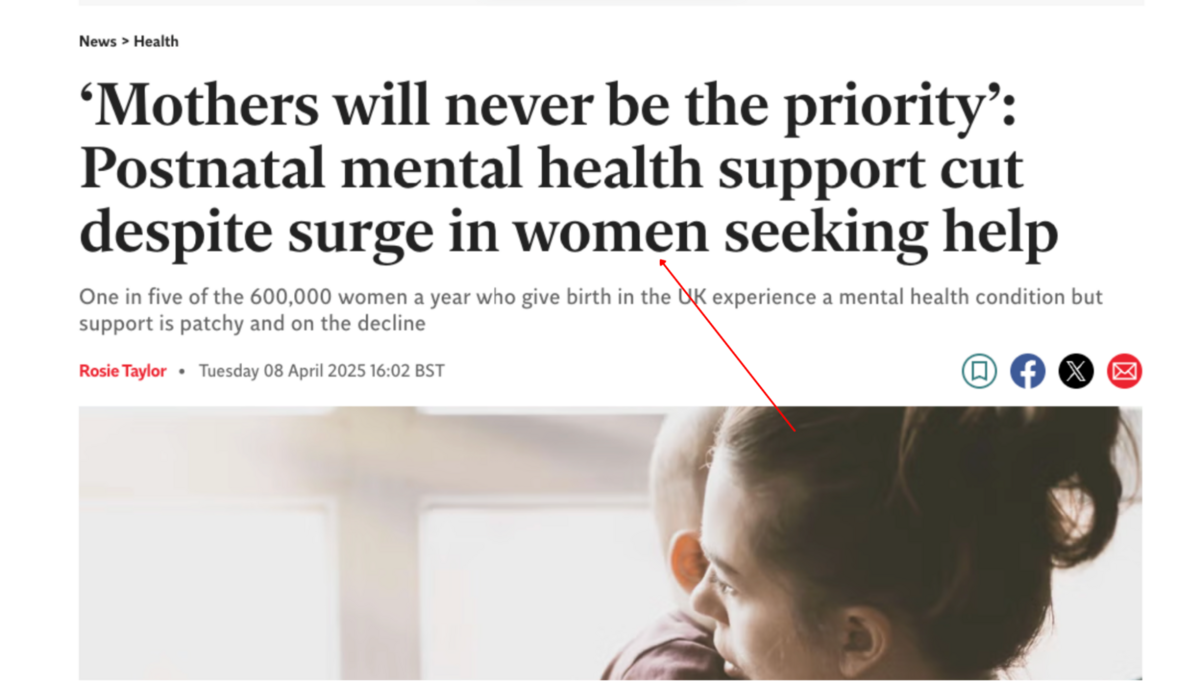
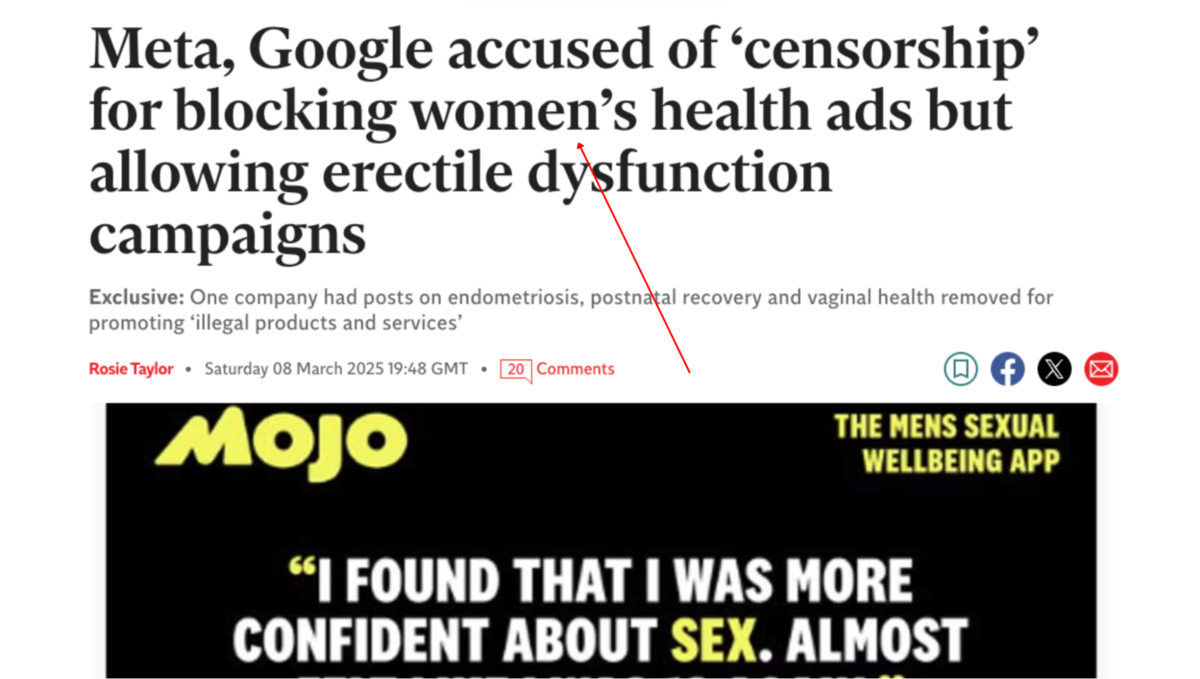
And not only that, she actually explained to me that the type of journalism she does is writing exclusive news and features.
And if you dig into her content, you do see that this is the case here:
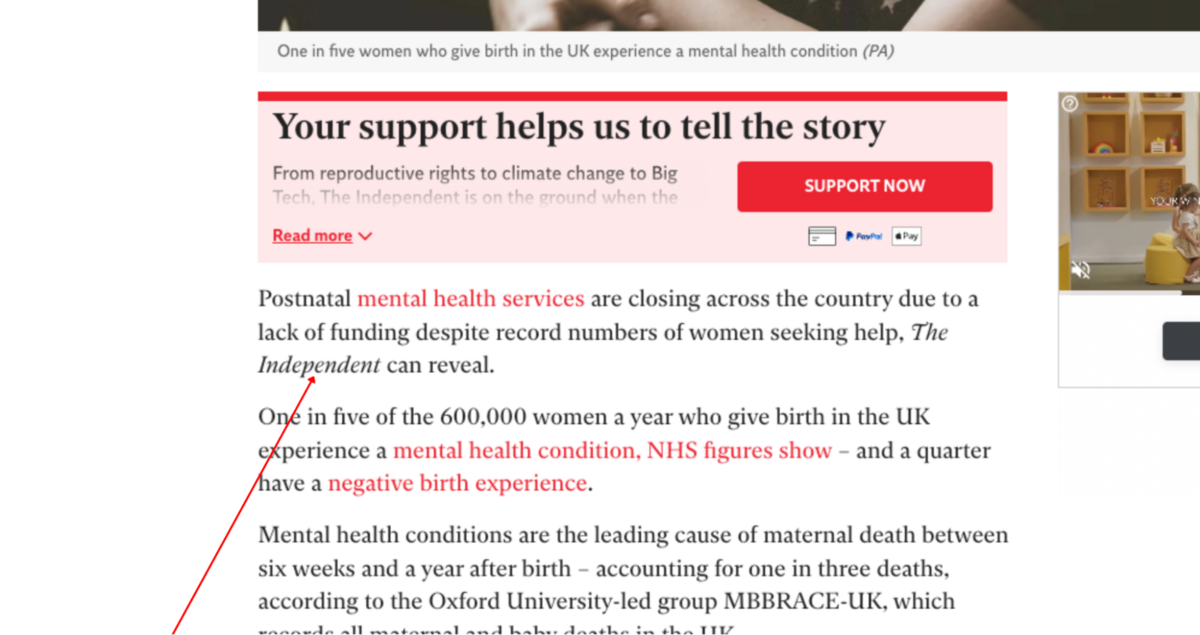
And none of this stuff is something you’d find on a media database.
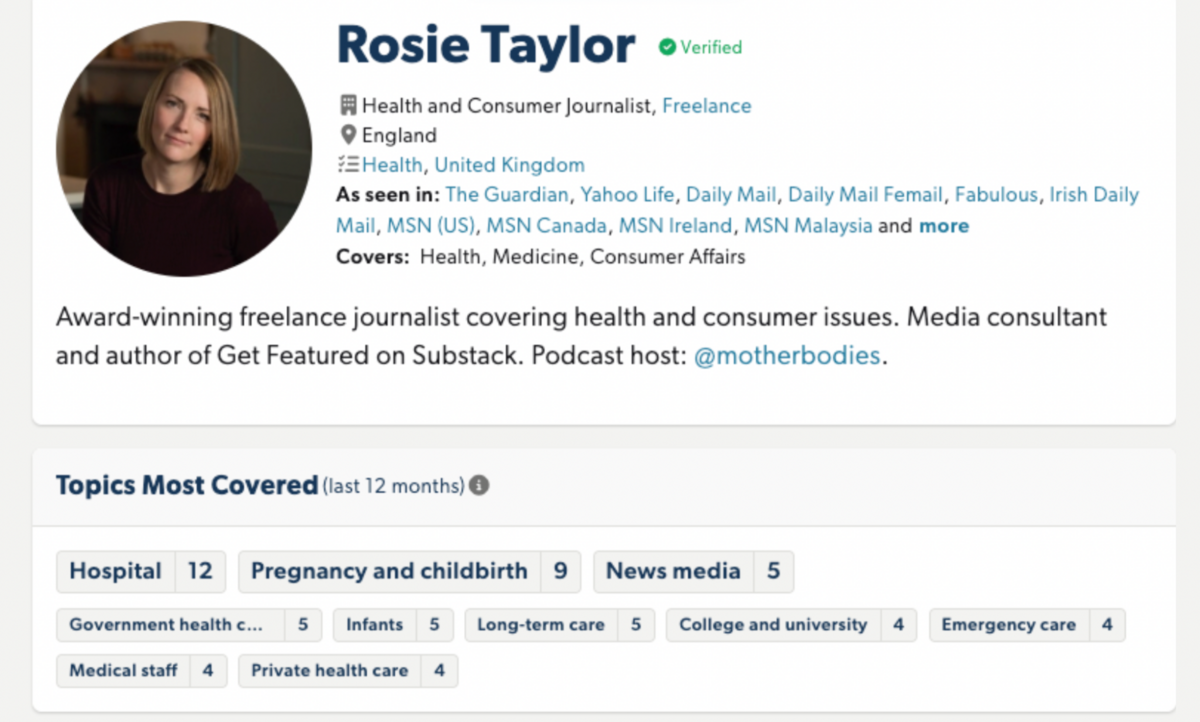
I don’t see anything in here about women, specifically women and families?
Types of Relevance
Let’s break down these relevance types.
Let’s pretend you have a client and you’re working on building a media list for a data analysis about Taco Buying Trends (I wrote this deck when I was in San Diego.)
Topical Relevance
So if I’m pitching this, I might be looking for someone who covers food.
So I’m looking at San Diego Eater.
Mona Holmes came up in a food search because she covers the James Beard Awards.
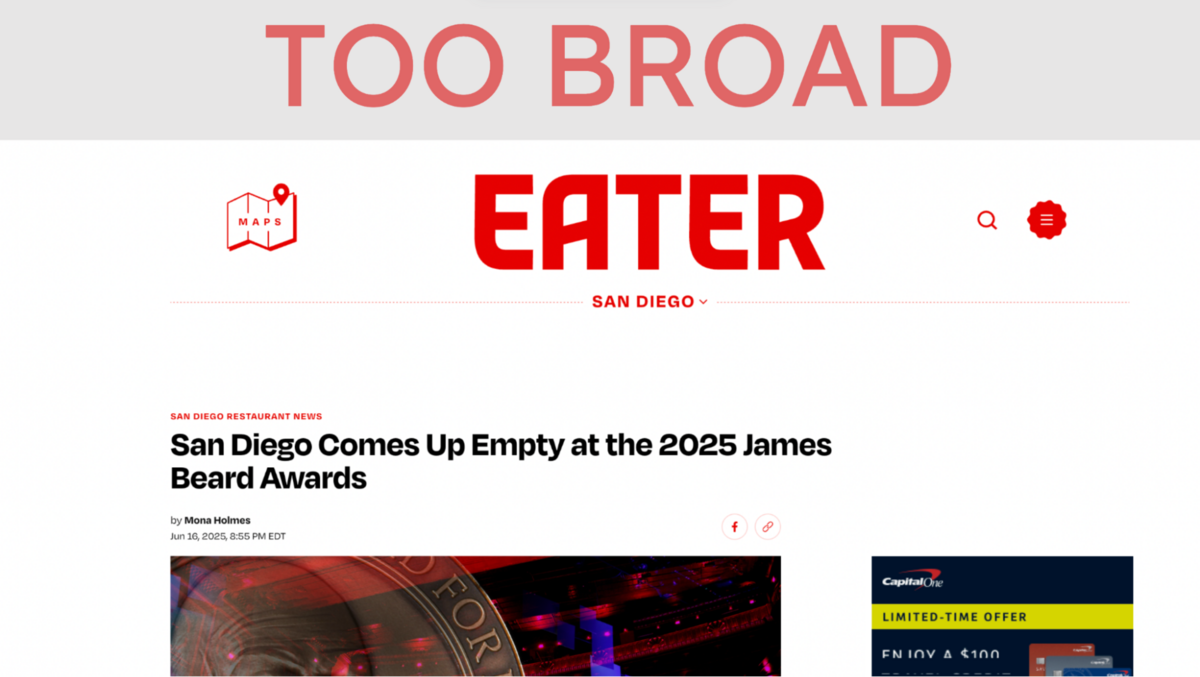
But this is too broad.
Yes, James Beard has to do with food, but I’d rather go for someone like Kim Smith, who’s covering a study about why avocado sales are down.

This is hyper relevant to my taco trends study.
Geo Relevance
Let’s get into geo-relevance next.
Here’s someone covering food news on CNBC: Jane Smith.

She’s covering America’s top 10 fast food chains.
This is a pretty, pretty big net, right?
She’s gonna be covering a broader scope.
From a geo perspective, I would much rather reach out to Jeff Cox, who’s covering Southern California’s surprising fast food boom.

So, matching it from a geo perspective.
Next is timing.
Timing Relevance
So, tax day food deals. We all know these kinds of social media days that we try to hook onto.

This is not the kind of stuff that you wanna necessarily anchor to because it’s gonna be too broad.
He’s talking about food deals, but has nothing to do with tacos.
Really what we want is the person talking about National Taco Day.
This might be a much more relevant piece for someone like Mike Snyder.
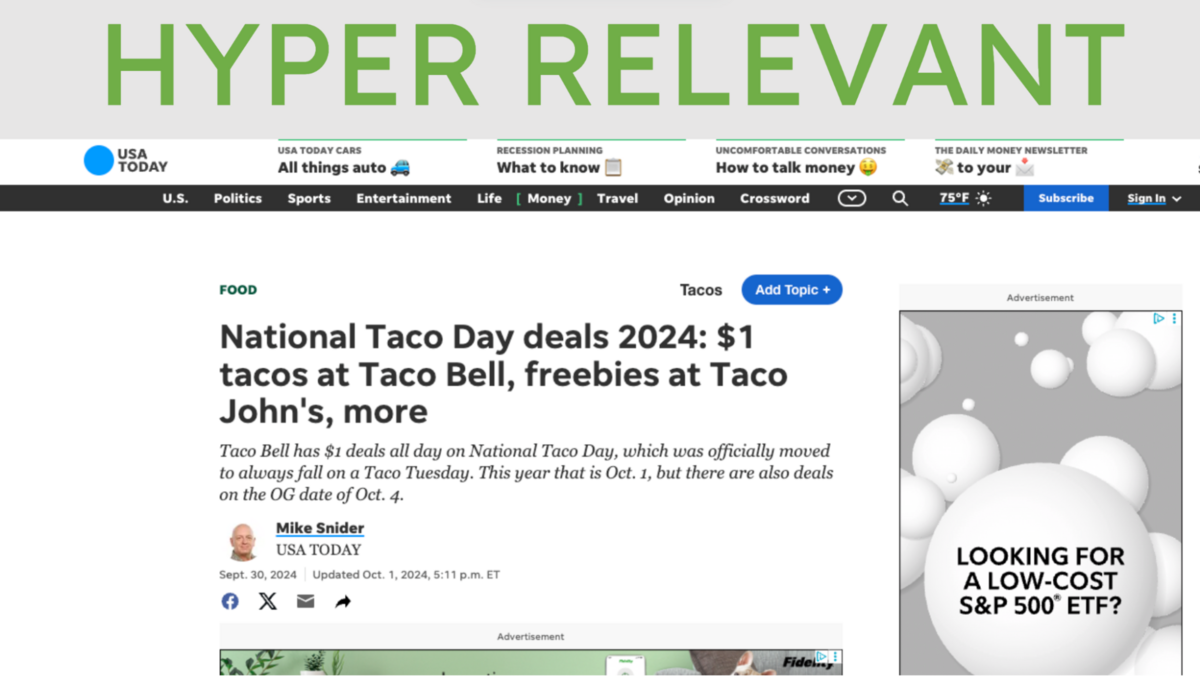
Lastly, this is the most essential concept.
Format Relevance
Actually, Rosie Taylor, who I mentioned earlier, just had a whole piece on this from her newsletter.
We wanna match the format.
So here’s Noel from Tasting Table, which is a relevant publication for a Taco Trends piece.
And here, Noelle, she tends to cover these listicle guides:

That’s not what we want.
We would much rather carry pitch this to someone like Martha, who covers news, specifically the popular Midwest chain that file for bankruptcy.
We want to give her the scoop:

So there is a big difference, and that type of thought process is gonna help you hone in and cut down your list.
Real Life Examples of Relevance
So now I’m gonna show you some real life examples.
GPU Survey from Fractl
I had a chance to speak with the great team over at Fractl, and they shared with me this one piece that they did.
It’s a survey piece covering GPU preferences.
They really nerded out on brand trust, budget limits.
You could see some of the stuff that they got.

Who and what are the most critical factors when choosing a GPU?
What sources do you trust when choosing a GPU?
And Kip shared the template with me, and you can see there’s a big focus on this in their template:
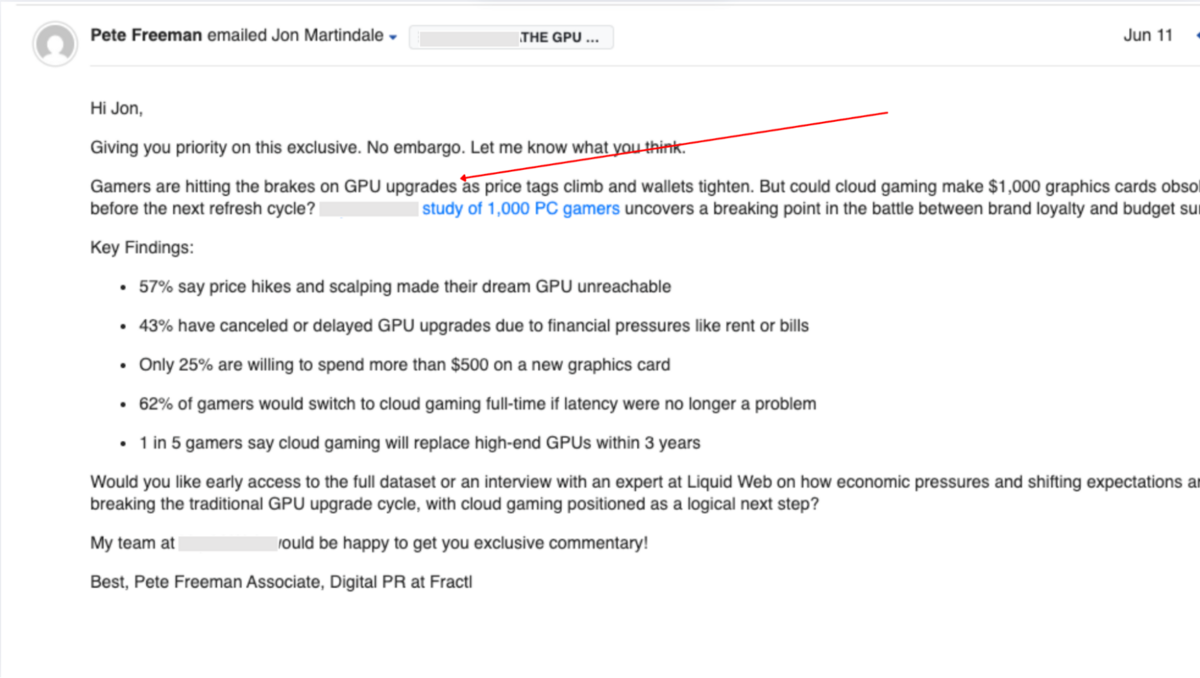
And he told me the way they really broke down their media list was by looking at relevant publications and then doing a site search to hone in on the right journalists.
And I love this approach.
But there are some caveats here.
If you’re doing this, not every writer is going to cover third-party studies.
So, like here I’m looking, I did a site search for gamer GPU, and I could see a lot of people, but a lot of these are reviews, right?
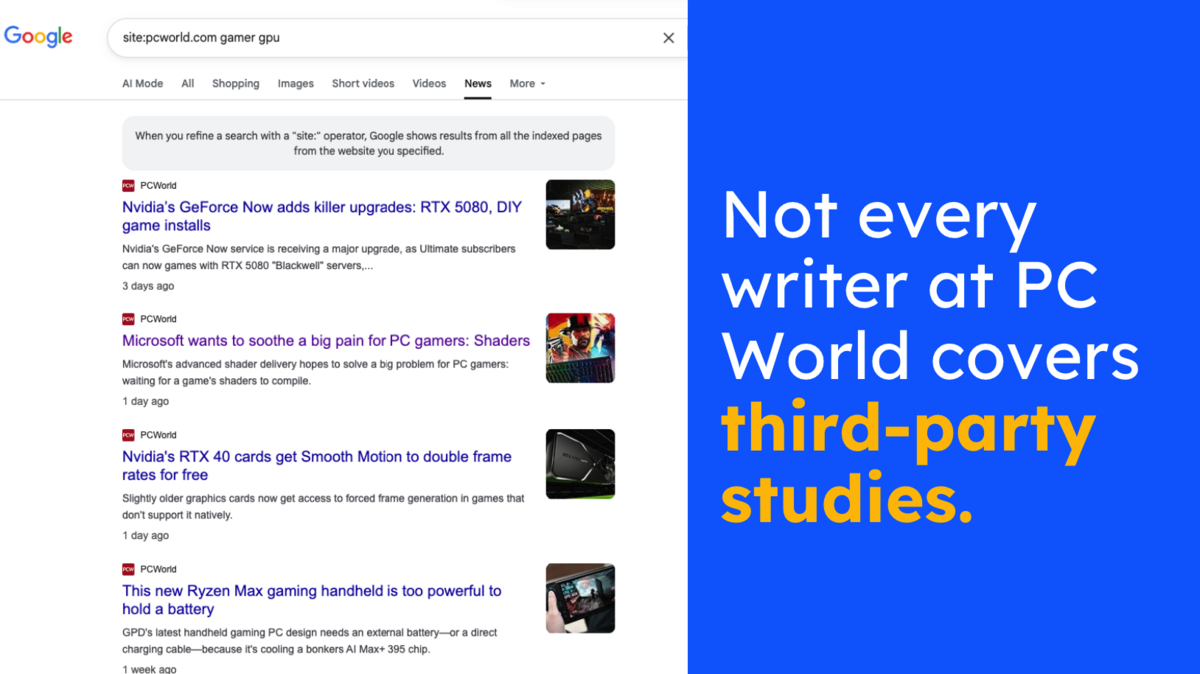
This is not the format that we want.
Some people only cover these product releases or reviews.
However, Jon Martindale, who covers third-party studies on other sites.

And you could see that’s the person who ultimately ended up covering their piece:
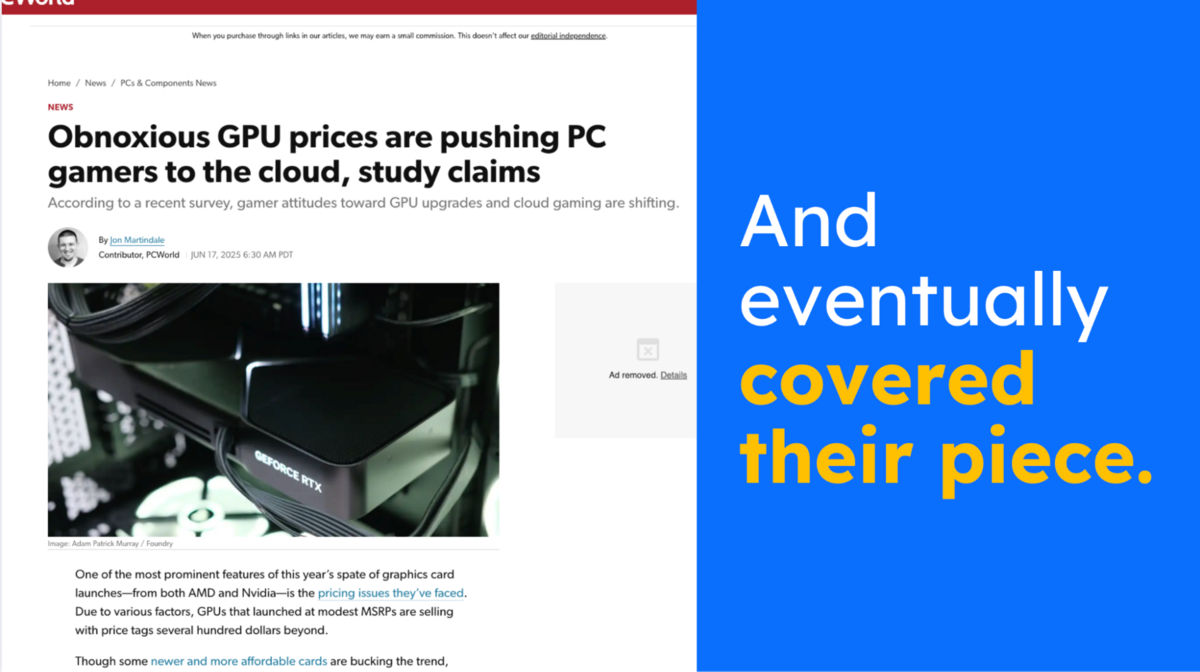
Third party, the guy that’s covering third party studies, that is the important one.
They sent about 53 emails total for this campaign and got almost the same amount of links and coverage.
Pretty impressive.
The Quietest Places in the World’s Loudest Cities
Alright, next is Olivia Lott. She’s a fantastic PR in the UK.
Olivia shared this piece with me. It’s called The Quietest Places in the World’s Loudest Cities.

Typically with this type of thing, you’re gonna pitch to local journalists in the cities that made the list, like Spokane, Edinburgh, and Phoenix.
They have these particular areas in the city that are super quiet.
So you’d reach out to these local journalists.
While researching, I’m looking at people who cover these types of “best cities”.
So here’s Mims Copeland, and she’s covering things like the best aviation museums, the best barbecue joints, best ice cream joints.
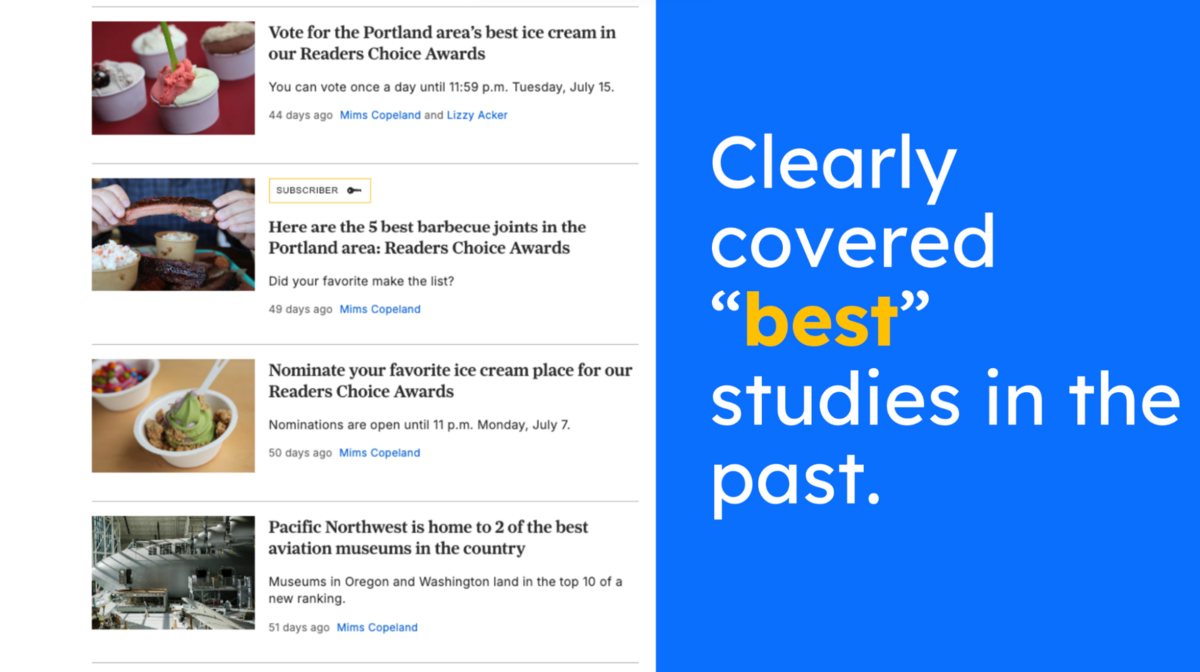
Ultimately, Mims is the person who covered Olivia’s piece.
But there’s more to this story.
The coverage in the Oregonian led to this newsletter, PDX Today, which is part of this 6AM network.
So basically, once Olivia found out that PDX Today was part of a network, she reached out to the editor and asked if they wanted findings for all of the cities they covered.
Olivia then created this big data set for all the different areas that they cover, and she was able to get a lot more coverage.
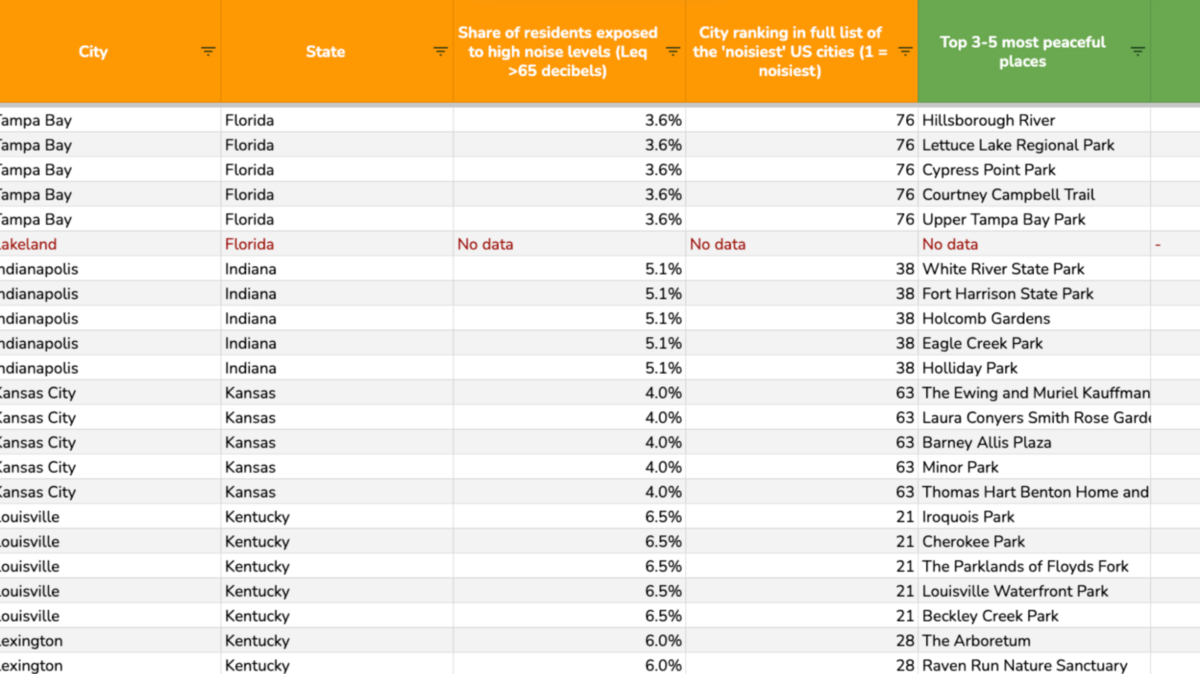
I love to see this type of personalized outreach because this is the kind of hard work that it really takes to get these kind of results.
She got over 150 links overall, but no city she reached out to had more than 25 emails.
I think that this again, speaks to this hyper relevance and hyper targeting.
Chamber of Commerce Study
Collin Czarnecki from Noble shared a piece, Cities with the Largest Gender Pay Gaps.
(I’m sharing a lot of these city-related studies, because not only are they super popular, but there are different takes on these. And I like to see the strategies that people are using.)
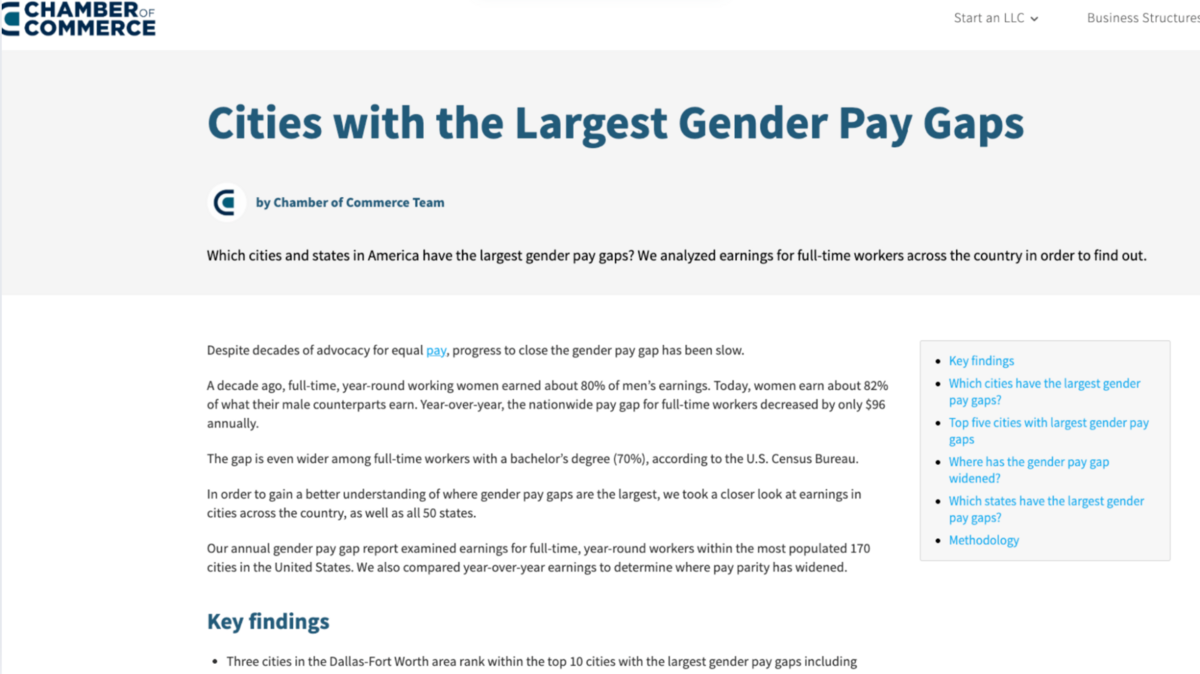
This is a typical city index study.
But you’re not just spraying and praying to everyone in Frisco or Irvine, for instance.
What you’re doing is trying to find reporters who have a history in covering these same types of topics like gender equity, labor, metro cost of living.
You can see in his email template that there’s this piece here that says “equal pay day.”
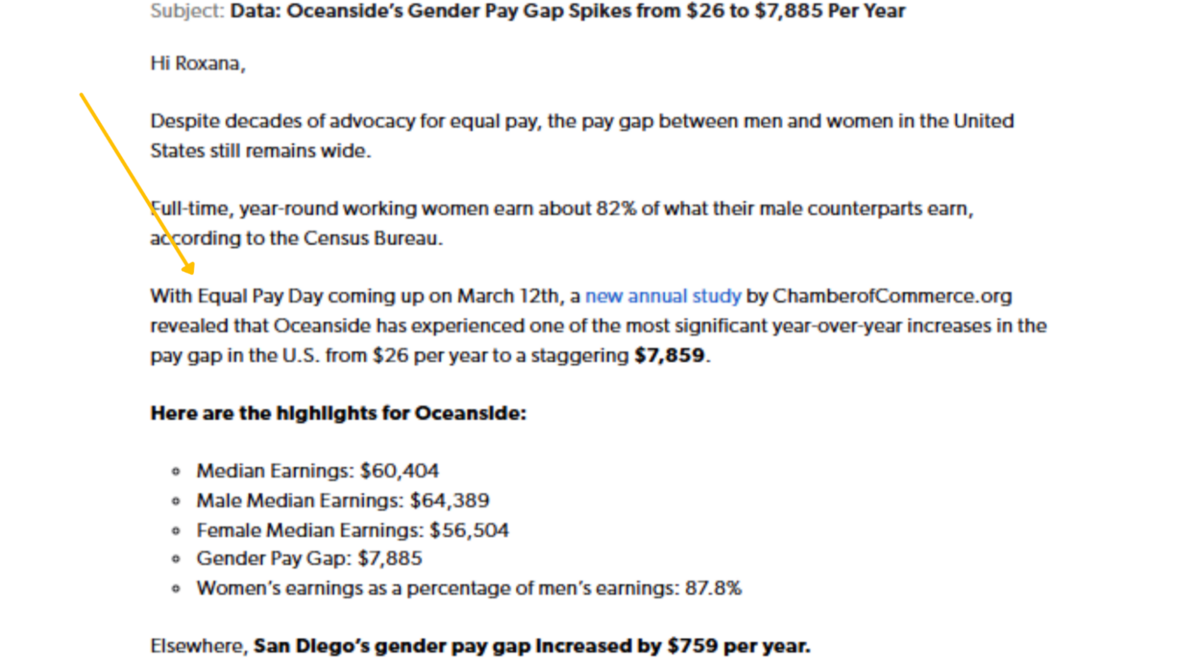
I did a quick Google search for equal pay studies, with the custom date range set to last year.
And boom, here’s this guy, Chris Morris.
He covered Equal Pay Day (actually International Equal Pay Day) last year.
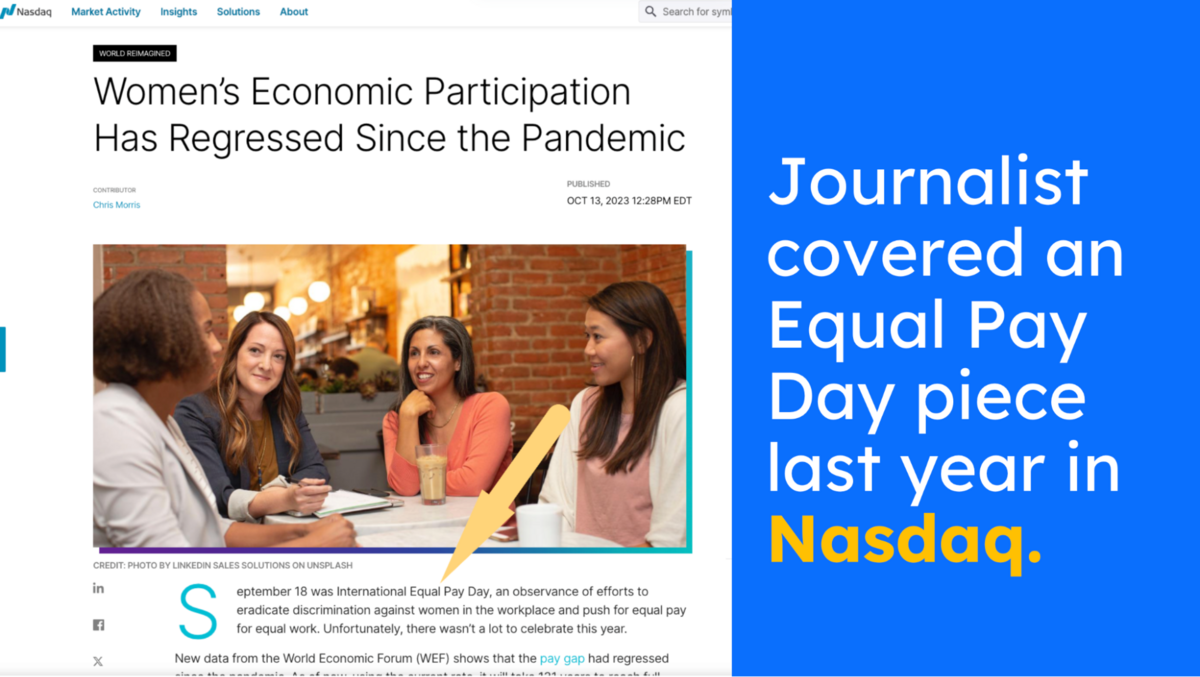
And lo and behold, this is the same Chris Morris who covered Collin’s piece this year.
So that, again, that’s the type of kind of timing, relevance, maybe that you wanna, you want to work into.
I also like wanted to call out how Colin does this hyper target breakdown based on people’s time zones:

As we know, not everybody’s in the same time zone, especially when you’re doing these city studies.
So you’re sending something at nine o’clock to someone from the East Coast, it’s gonna get to them at 6:00 AM on the West Coast, and so forth.
The results were 70+ links, but ultimately about 30 emails per angle, which is pretty killer.
Major League Looks
Alright, last one, I wanna share this piece from Rise at Seven.
Not only do they do great work, but this one is near and dear to my heart as a huge baseball fan: The Major League Looks piece.

So they did this fun study where they basically came up with this list of the best-looking mascots and managers in the US.
And the way Madeleine Dykes explained to me how they built their outread list was that they focused on local journalists and national reporters, specifically on culture and trending news.
They also took it a step further, and what I wanna call out here is the personalization for each local team and stadium because I think this is very important.
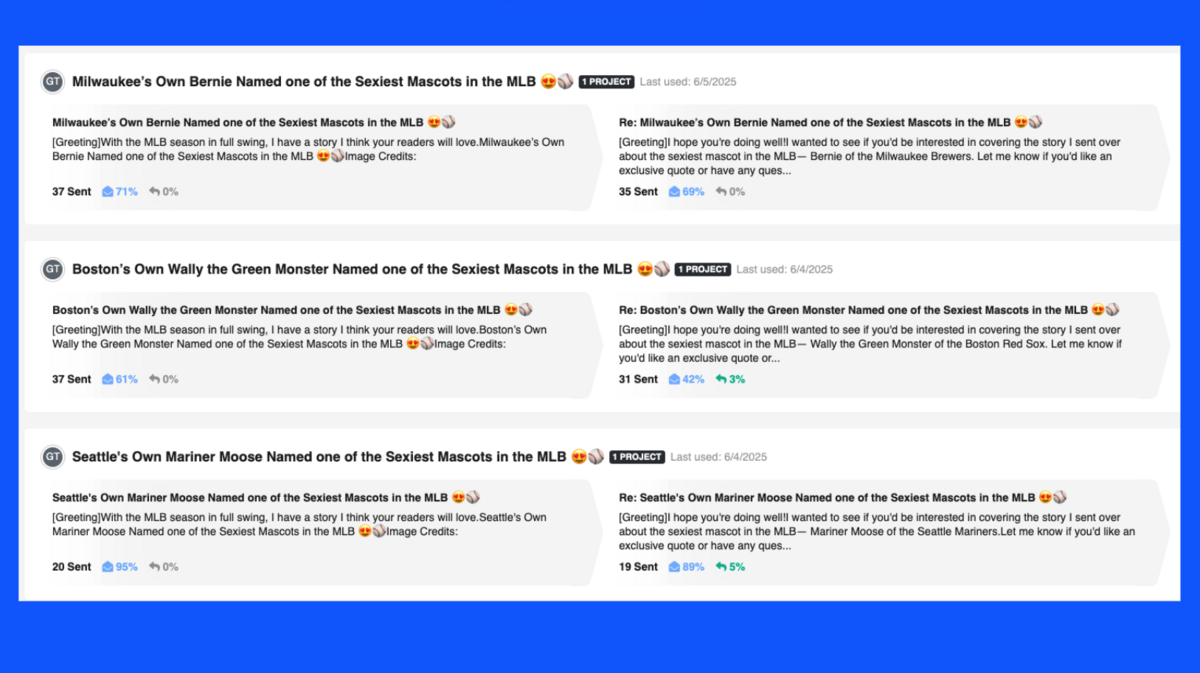
And you could see when you jump into the different templates here, they have one for everybody on this list, right?
Milwaukee’s, Seattle’s Mariner Moose, Wally the Green Monster from Boston, and here’s my favorite (I’m a big Phillies fan), their template for the Philly Phanatic:
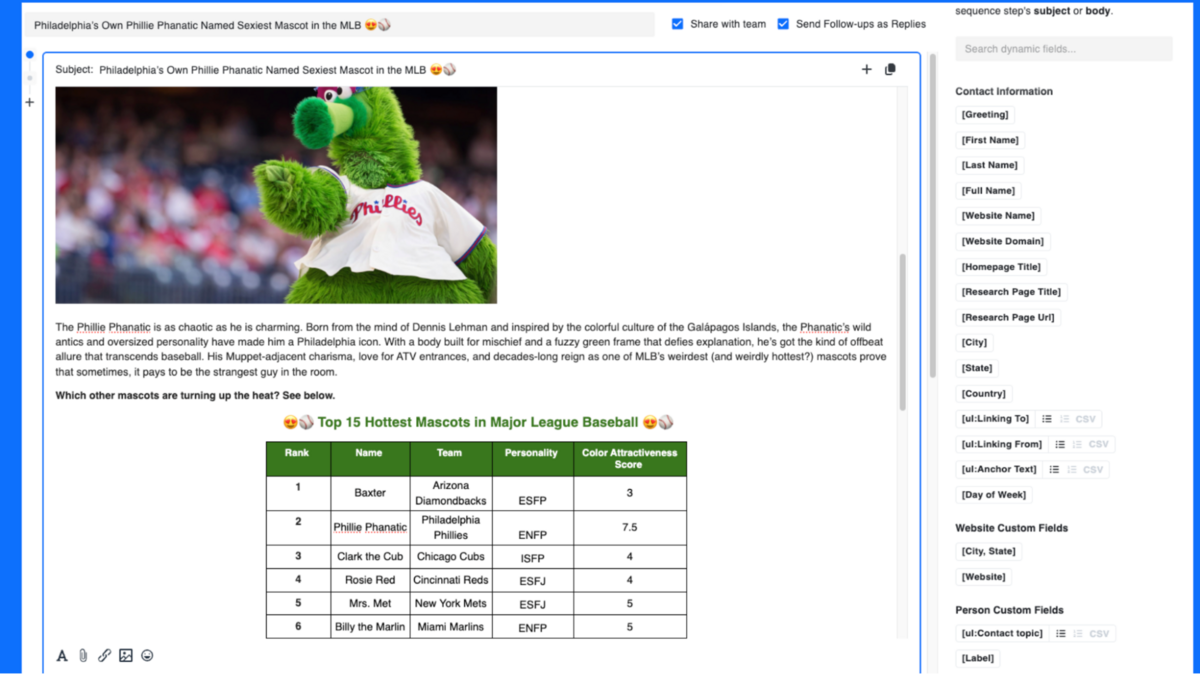
I’m a little sad that he came in second place.
As you can see, he lost a Baxter, which, I pretty bummed about.
But let’s go into how they did it, right?
Here’s someone. Fox 29, Philadelphia who covered their piece.
Suppose I’m reaching out to somebody in the Philadelphia area. In that case, I’m finding these news stations and looking for people like Amanda Hurley, who covers consumer regional news in the Northeast News sector.
She’s my target.
It helps that she clearly also covers Philly’s related news; you can see, looking at the related articles right here:
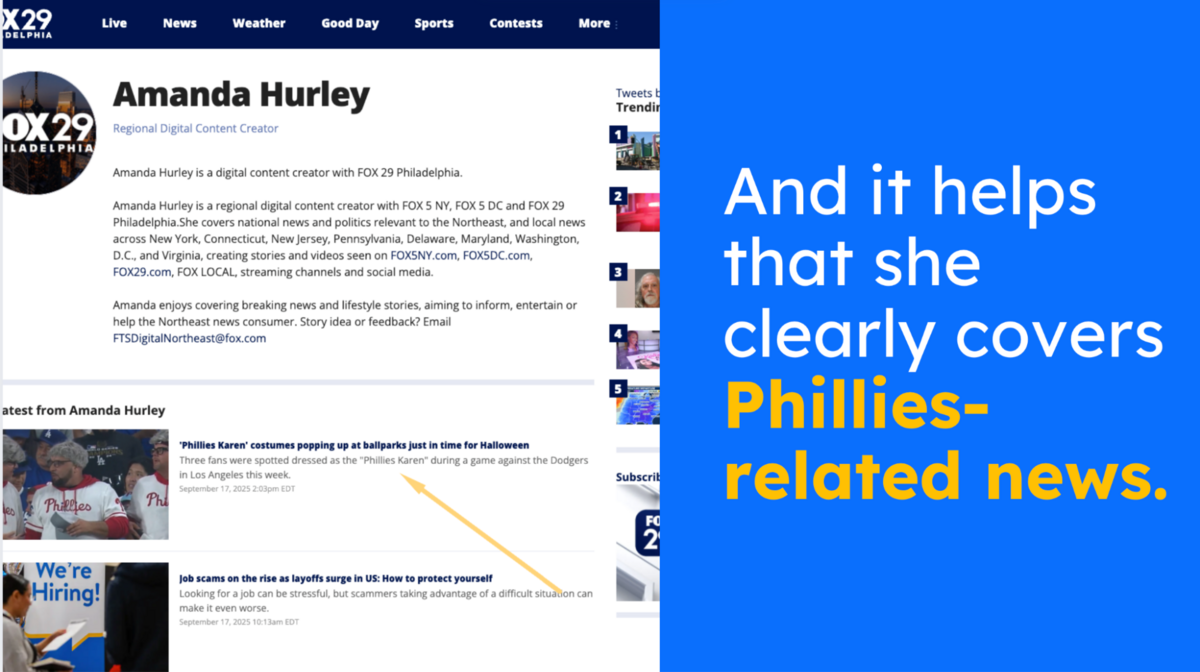
So that’s the hook and ultimately, she covered the story.
This is that geo targeting that I was mentioning before, but also topical targeting.
That’s the type of thought process you need and digging into it.
They sent about 49 emails for this Philly area specifically and got 19 links for just that angle.
I think that’s pretty solid overall.
The piece got about 60 links, and is still cooking because it was sent right around the playoffs.
This requires a mindset shift
So for a lot of people, this is gonna be a mindset shift because it takes a lot to do this type of thing.
And for us, this is a mindset shift for BuzzStream.
We are putting some pretty big bets on this being the future of outreach and creating new products for this type of outreach.
We see on the other side how challenging digital PR is getting and why we’re getting fewer returns on the same type of outreach.
So I want you to reject these pieces of “advice” that you see online telling you to send a million emails a day, or bragging about the millions of emails, because it’s just adding more noise.
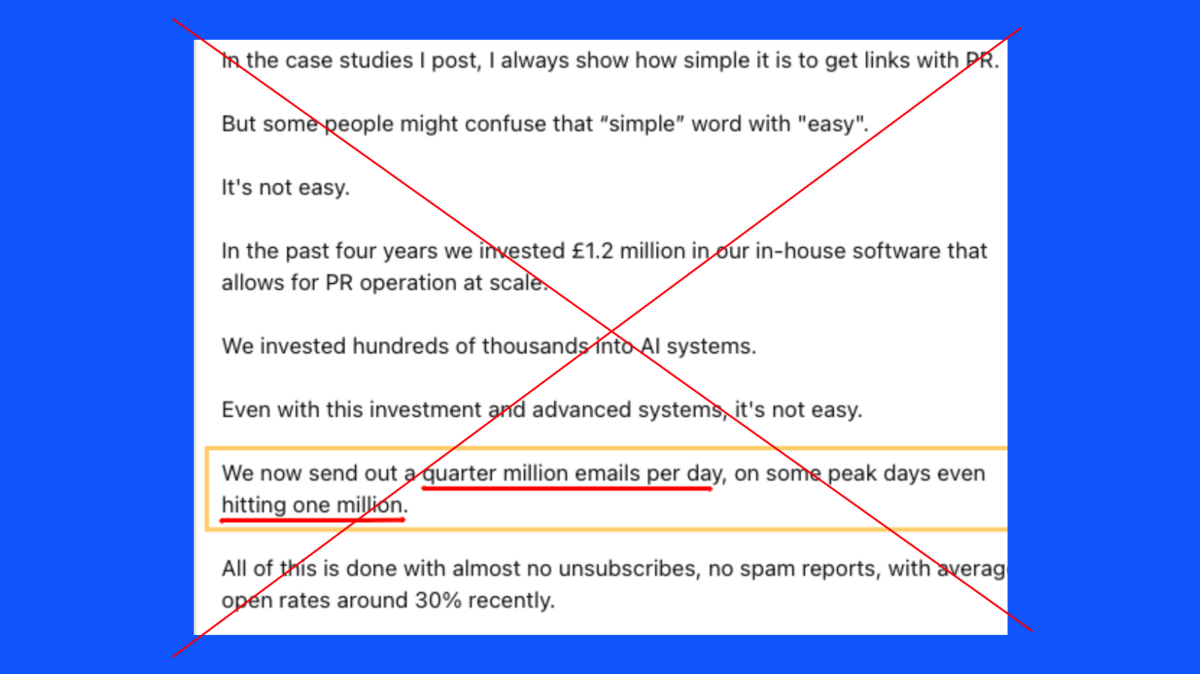
We have these conversations in-house, too.
It’s like, why aren’t more people doing it this way? If it seems so simple, right?
Why aren’t more people doing it this way?
Ultimately, I think it just comes down to time.
Agencies are so focused on billable hours and that sort of thing, but this takes time.
Say I wanted to do some kind of reactive piece on the flight cancellations happening in the US, for example.
Typically, I run a news search for “flight cancellations”.
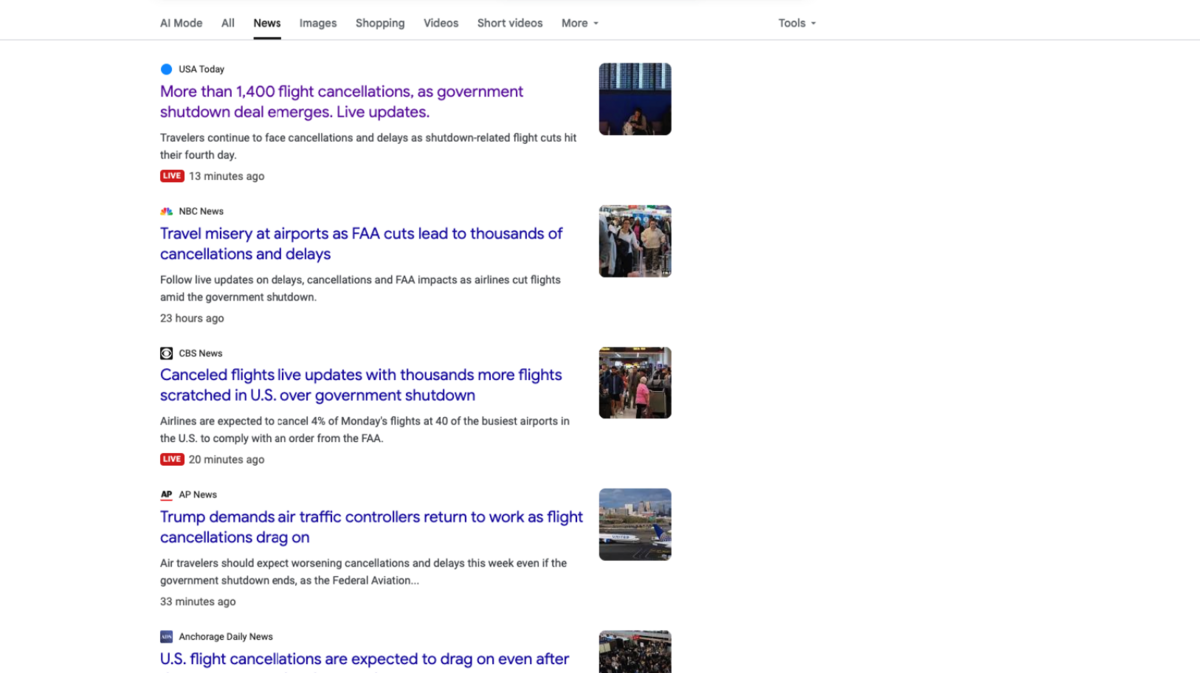
And if I’m trying to do a reactive piece, I’m clicking into each of these results, looking for the author, reading the article and the journalist’s bio, and then asking myself:
- Is he a good fit?
- Can I pitch him my reactive piece?
Then I’m gonna read all of his recent articles, scan through 10 or 20, depending on how frequently this person publishes stories.
Then I’m digging around to find the email, since it wasn’t on the bio page.

So now I’m doing some search like this, and you’re going down a rabbit hole, opening a thousand tabs for everyone who’s done this this can take a lot of time.
Then I need to find Alex’s email. Then I’m gonna go to the next journalists and dig around. Repeat the same process that can easily take 10 minutes per journalist.
And if you’re doing a hundred journalists, that’s a lot of time.
How can ListIQ help?
ListIQ is our new media list building tool designed to help PR professionals build hyper-relevant lists from Google News.

Let’s say we’re doing this reactive workflow again for flight cancellations.
I’m in Google News search.
I enable list IQ and tell it which of these URLs I want it to analyze.
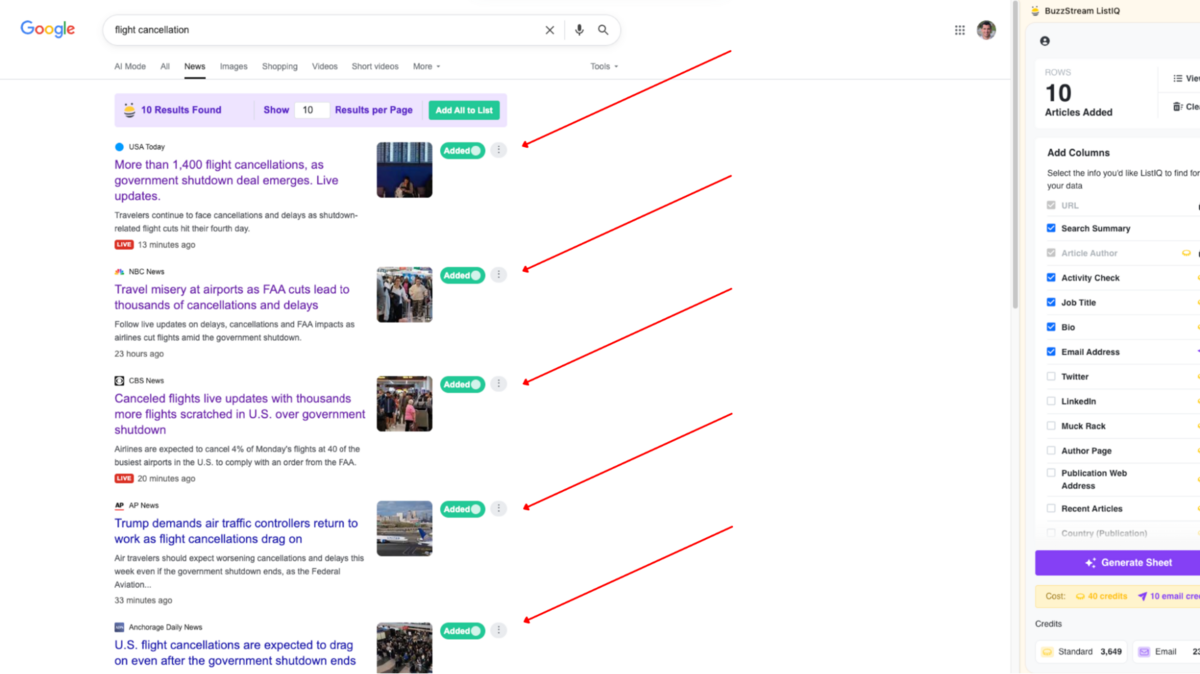
Then I’m gonna go over to ListIQ and say, okay, now I want:
- The search summary.
- I want to know their activity check. Are they still active at the publication?
- I wanna know their bio,
- Their job title.
- Obviously I wanna know their email address.
- I want some recent articles.
Then I click Create Sheet. It’s gonna go and do this heavy lifting for me, and boom, I have a Google sheet now with the article author for each of these.
I have their email address, and these are verified email addresses.
By the way, this is not guessing or using pattern matching like hunter.io or RocketReach.
We’ve seen in a lot of our studies that that stuff just doesn’t work, especially for journalists.
Now I can see all of the information I need to build my relevant email list:
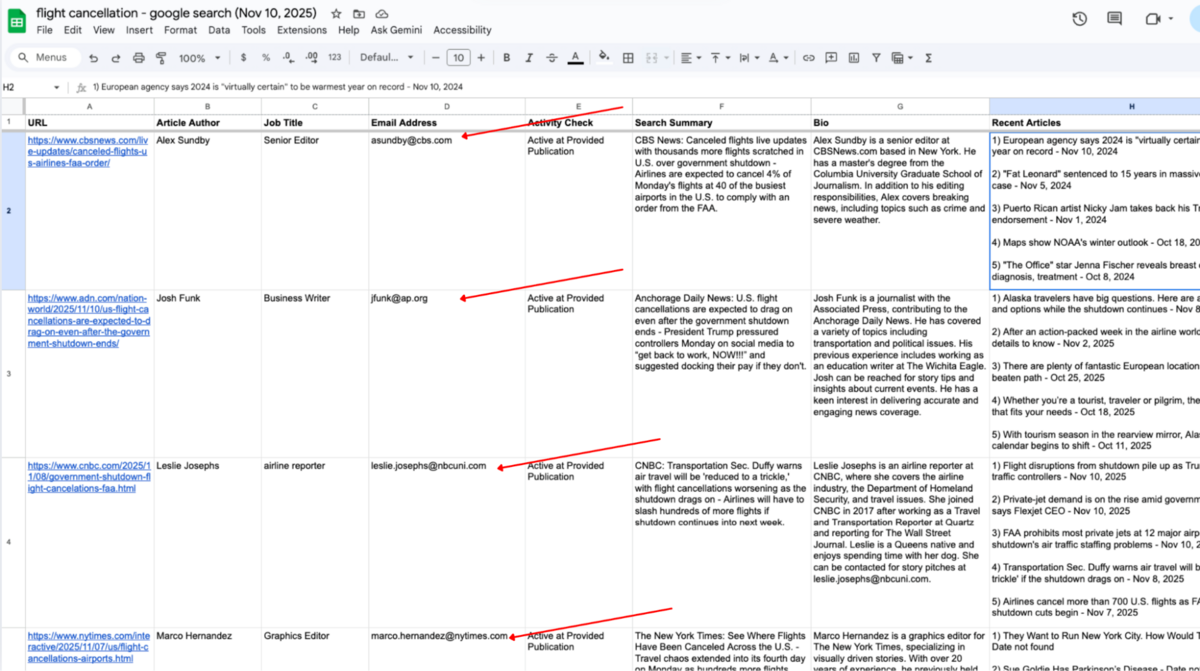
We can see if they’re still active within the past 30 days at their publication.
Are they still publishing things? This is especially obviously important for reactive.
Then we see their bio, and here I’m being able, I can clearly pick out, Alex here, he covers breaking news.
Here’s Josh, he covers transportation and political issues.
There we go. Boom.
There’s our connection to travel issues.
So we also have recent articles and all this to show that this is what it takes to do.
This is the targeted outreach, right?
This is what we need. This is how you need to be thinking. This is what ListIQ is all about.
You can ping me and LinkedIn and let me know you want access. I’m happy to run people or their teams on how to use this stuff.
But also, you want me to build you a list, I’m happy to do that too.
The Story Has a Happy Ending
Now I said I was gonna come back to that story from the very beginning because iit does have a happy ending.
So, remember these people that got banned from their email providers?
We talked to them and showed them the data? You could see that before, a lot of their campaigns’ templates had 490 sent, 892 sent, 25% open rate, no responses, no links, no clicks.

And after we’ve walked them through what it really takes to do who this targeted outreach, they’re seeing way better returns, more clicks, replies, better open rates, and clearly a lot smaller, more targeted media lists:

So I said that this was tough, and it is a mindset shift. I want to share a handful of people that I think you should be following.
Resources for the Mindset Shift
Here are some of the best resources for this mindset shift.
Digital PR Explained
Britt Klontz has a fantastic podcast called Digital PR Explained.
And the reason I really like Britt’s work is because she in a lot of her episodes, they might go a full episode on one piece of coverage and the amount of time and effort it took for someone to score one piece of big coverage.
And I think again, we have to get back into that mindset as digital PRs, we need to steal some of this mindset from the traditional side of things.
Get Featured
Rosie Taylor, as I mentioned, has a great Substack called Get Featured.
She was the journalist mentioned in this deck, but she also does this kind of side project where it’s just tips on how to get yourself featured and get coverage.
Collin Czarnecki
I mentioned Collin’s piece of content earlier, but he also has a great newsletter called Pitched.
Colin was a former journalist as well, so he has some fantastic ideas around that.
Mark Rofe
Mark Rofe, is the OG in the space, especially in the UK. He has a digital PR newsletter.
It goes out about twice a month.
BuzzStream
BuzzStream Podcast and Newsletter
And of course, the BuzzStream podcast and newsletter.
Gotta give myself a shout out there. And I appreciate everybody who sends me their tips and stuff for this newsletter.
Questions?
Let me start here because I have a handful of questions that people had asked and submitted.
How to have conversations with clients?
The question here was that a lot of clients come into this stuff with very high expectations.
Yes, having these conversations with a client that you are going to expect fewer pieces and I think I’ve done a lot of research and I can share some of this stuff with people and hopefully this helps, but I think the expectations do need to be lower for clients these days.
And I think there are fewer links to go around.
I’ve done a lot of research on this, the value of a link, the cost for a link, but not only cost, but the value because of the cost.
It has bumped up extremely high.
And, there’s some studies that I’ve done looking at if you were to go buy these links on a marketplace, some people are charging for high-end news links like this, $10,000, which is insane to me, but that gives you a sense for what you should be expecting.
And I think it’s totally reasonable to show and compare some of these things with potential clients.
But all that said, like at the end of the day, you need results, right?
Aside from ListIQ, how do you find relevant journalists?
There’s this acronym I’ve been working on, it’s this F.I.T. acronym to things to look at and it follows that, those hyper relevance, but it’s, you wanna make sure they’re in the right industry.
And that’s something that you could do, as a general sweep, just based off of a category.
Say you’re going to a website you look under the categories that you want first and finding a journalist that way.
Site searches I think work really well.
Just you go to the specific site and do a site, colon and then write the site in and then the specific keywords that you’re looking for.
But I think the bios in recent articles are really gonna tell you, what you want because you’re gonna be able to match that kind of topical relevance, but also for the most part, you’re gonna be able to get some of that format relevance too.
So you’re gonna be able to understand the types of articles that these people are looking at and the types of articles they share.
And another big piece of this I think is the search operators that can help.
So when you’re thinking about search operators. You want to be thinking about the types of headlines that you might be getting for the piece that you are pitching. So for instance the example I use a lot is say you did a study, general study for us audience.
If I were to search most Americans.
Typically that is how journalists a lot of the times, will share a survey.
And so my go-to search query for that is most Americans plus whatever topic, most Americans plus flights.
If I did a study around flight times, missed flight times or whatever, delays at airports, there’s also, new survey survey reveals look for these key phrases that are gonna help you uncover journalists who have covered the same type of content, the same format that you are pitching. Okay, there is another question on here.
Is it best to send emails directly from Outlook, Gmail, et cetera?
We’ve dug into this a bit.
I think all of them at this point have very similar restrictions and spam guidelines.
So it really depends on how you’re doing and who you’re reaching out to.
But at the end of the day, any type of bulk sending I think is gonna get you flagged.
From your providers, so it doesn’t seem like there’s any deliverability or open rates that are better from one platform to the next.
It is all really pretty similar.
It really varies depending on the person behind the emailing. So if you ever see studies like that, I would take those with a grain of salt because, two people could be sending from Gmail and one of them is blasting out emails and the other one is doing a great job and, that’s gonna skew the data in a big way.
Okay, cool. Let me check on the chat here to see if we have any questions in the chat.
How to find the right journalists on a media database?
Great question. Mina, I covered this a little bit, I think for the most part, a lot of people do still try to use media databases.
The issue I think, is that there are some that are just not as accurate as others.
So I think thinking about how you use it, still, I would still recommend doing a deeper search.
Like, maybe use a media list to gather people, but you still have to go through and evaluate them based on recent articles and the types of articles.
A media list, like we said, does not show that kind of stuff.
It does not show the format.
So you do need to get in there.
And that’s why anytime I’ve ever built a list, it’s always from scratch.
I feel like if you’re using a media database, you end up doing a lot of the same extra work.
Thanks everyone for showing up and stay tuned for the next one.
Here is the full slide deck below:

 End-to-end outreach workflow
End-to-end outreach workflow


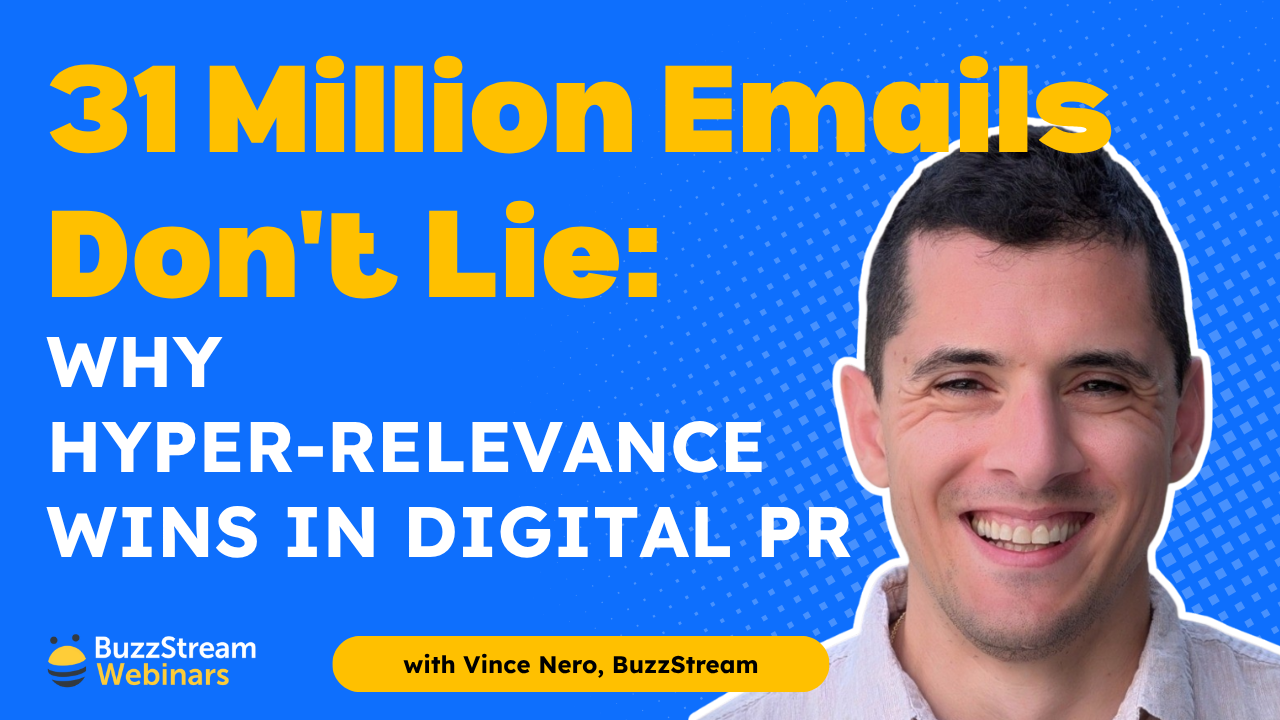
 Check out the BuzzStream Podcast
Check out the BuzzStream Podcast







